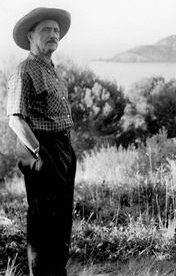Encounters
“Assemblers of seasons at the highest points of intersection.”
Birds, I
Saint-John Perse forged friendships with many writers, musicians and painters of his time. As a student in Pau, he met the writer Francis Jammes in 1902 who introduced him to Paul Claudel. While studying law in Bordeaux, he corresponded with the prominent writers from the Nouvelle Revue Française : André Gide, Jacques Rivière, Valery Larbaud, Léon-Paul Fargue and Paul Valéry.
Through the art collector Gabriel Frizeau, he came in contact with Gauguin’s paintings, Odilon Redon meth, André Dunoyer de Segonzac and André Lhote, who introduced him to the African art, Fauvism and Cubism. During a trip to England in 1912, he visited Joseph Conrad and Rabindranath Tagore.
In Paris, in the excitement of the beginning of the century, he went with the young composer Claude Debussy to the premiere of Rite of Spring. He spent time in the salon of pianist Misia Sert, a friend of Diaghilev, director of the Ballets Russes.While in the press corps at the Qaui d’Orsay, he worked with Jean Giraudoux, Paul Morand and Jean Cocteau. As Secretary of Embassy in Beijing from 1916 to 1921, he met Victor Segalen and China and Tibet scholars Marcel Pelliot, Granet and Paul Jacques Bacot.
While he was in China, his youthful poems “Praise” and “Images Crusoe” were set to music by Darius Milhaud and Louis Durey the Group of Six. On his return from China, he frequented the circle of the journal Commerce alongside musicians Erik Satie, Darius Milhaud and Igor Stravinsky and poets Paul Valéry, Léon-Paul Fargue, Valery Larbaud, T. S. Eliot, Archibald MacLeish and Rainer Maria Rilke. He had a brief affair with Marie Laurencin. Guillaume Apollinaire and Marcel Proust both devoted his poetry. André Breton called him a “proxy surrealist” in his Manifest of 1924. René Crevel and Roger Vitrac went to see him. Rainer Maria Rilke translated a fragment of “Images Crusoe”. Walter Benjamin, Giuseppe Ungaretti, then T. S. Eliot undertook translations of Anabasis.
During his American exile, he came to know Edgar Varèse, Igor Stravinsky and Pierre Boulez. Despite his exile in the U.S., his literary reputation and relationships with the Parisian milieu of Commerce contributed to maintening links. The director of the Library of Congress, writer Archibald MacLeish, the poet-critic Katherine Biddle and her husband Francis Biddle, Minister of Justice under Roosevelt, became friends and protectors along with Mina Curtiss. Saint-John Perse maintened voluminous correspondence with two great figures of twentieth-century American poetry : T. S. Eliot and Allen Tate.
He was friend with Alain Bosquet, Roger Caillois, Pierre-Jean Jouve, Jean Paulhan, Jorge Luis Borges and Octavio Paz. In Provence, the author of Seamarks (“Seamarks“) was fervently awaited by René Char, John Ballard and his staff at Cahiers du Sud.
To date there are more than forty musical adaptations of his work. Many musicians are tempted by this polyphonic poetry : Paul Bowles, Alan Hovhaness, Karl Birger Blomdahl, Wolfgang Fortner, Hermann Reutter, Boucourechliev, Elliott Carter, Maurice Racol and more recently the Finnish composer Kaija Saariaho. Visual artists were also inspired by his work. From the thirties, Louis Marcoussis and Giorgio de Chirico seized on Anabasis. They were followed by Georges Braque, André Marchand, Zao Wou-Ki, Lucien Clergue, Antoni Clave, Claude Garanjoud and others. Among the contemporary writers, of particular note is the importance of Saint-John Perse for Creole authors such as Patrick Chamoiseau, Raphaël Confiant and Édouard Glissant


